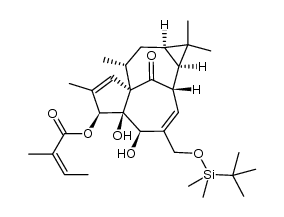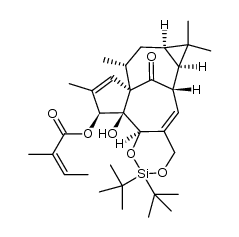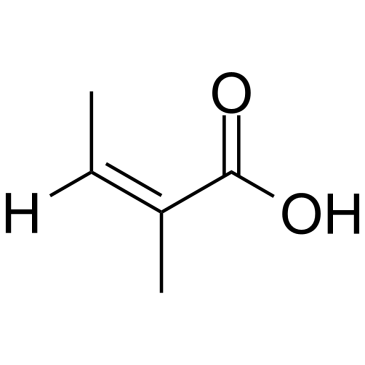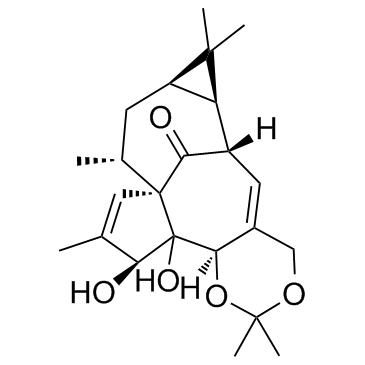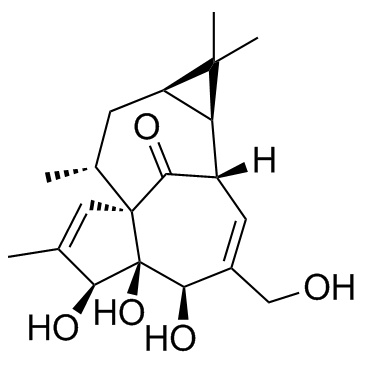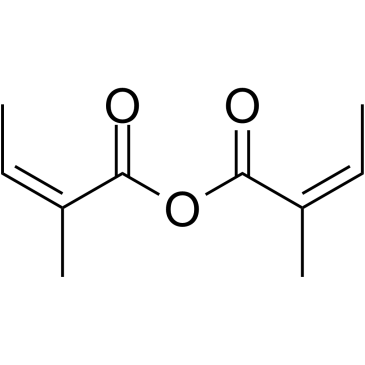75567-37-2
| Name | ingenol mebutate |
|---|---|
| Synonyms |
Indoxyl |A-D-galactopyranoside
3-O-angeloylingenol 2-Butenoic acid, 2-methyl-, (1aR,2R,5R,5aS,6S,8aS,9R,10aR)-1a,2,5,5a,6,9,10,10a-octahydro-5,5a-dihydroxy-4-(hydroxymethyl)-1,1,7,9-tetramethyl-11-oxo-1H-2,8a-methanocyclopenta[a]cyclopropa[e]cyclodecen-6-yl ester, (2Z)- Ingenol 3-angelate 3-Indolyl-b-D-galactopyranoside (1S,4S,5S,6R,9R,10R,12R,14R)-5,6-Dihydroxy-7-(hydroxymethyl)-3,11,11,14-tetramethyl-15-oxotetracyclo[7.5.1.0<sup>1,5</sup>.0<sup>10,12</sup>]pentadeca-2,7-dien-4-yl (2Z)-2-methyl-2-butenoate indican (glucoside) Picato Ingenol mebutate (1S,4S,5S,6R,9R,10R,12R,14R)-5,6-Dihydroxy-7-(hydroxymethyl)-3,11,11,14-tetramethyl-15-oxotetracyclo[7.5.1.0.0]pentadeca-2,7-dien-4-yl (2Z)-2-methyl-2-butenoate Ingenol-3-angelate 3-Ingenyl angelate 3-Angeloylingenol |
| Description | Ingenol Mebutate is an active ingredient in Euphorbia peplus, acts as a potent PKC modulator, with Kis of 0.3, 0.105, 0.162, 0.376, and 0.171 nM for PKC-α, PKC-β, PKC-γ, PKC-δ, and PKC-ε, respectively, and has antiinflammatory and antitumor activity. |
|---|---|
| Related Catalog | |
| Target |
PKC-β:0.105 nM (Ki) PKC-γ:0.162 nM (Ki) PKC-ε:0.171 nM (Ki) PKC-α:0.3 nM (Ki) PKC-δ:0.376 nM (Ki) |
| In Vitro | Ingenol Mebutate (Ingenol 3-angelate) is an active ingredient in Euphorbia peplus, acting as a potent PKC activator, with Kis of 0.3, 0.105, 0.162, 0.376, and 0.171 nM for PKC-α, PKC-β, PKC-γ, PKC-δ, and PKC-ε, respectively. Ingenol Mebutate also EC50s of 13 ± 2.4 nM (PKC-α), 4.37 ± 0.4 nM (PKC-βI), 10.5 ± 2.2 nM (PKC-βII), 38.6 ± 2.9 nM (PKC-δ), 1.08 ± 0.01 nM (PKC-ε), 0.9 ± 0.13 nM (PKC-μ) in WEHI-231 cells, 198 ± 12.5 nM (PKC-α), 69.1 ± 8.2 nM (PKC-βI), 4.6 ± 0.4 nM (PKC-ε) and 1 nM (PKC-μ) in HOP-92 cells, 635 ± 245 nM (PKC-α), 146 ± 35 nM (PKC-βI), 4.7 ± 0.7 nM (PKC-δ), 1.1 ± 0.5 nM (PKC-ε), and 30 nM (PKC-μ) in Colo-205 cells. Ingenol Mebutate sensitizes WEHI-231 cells, HOP-92 and Colo-205 cells, with IC50s of 1.41 ± 0.255 nM, 3.24 ± 2.01 nM, and 11.9 ± 1.307 nM, respectively[1]. Ingenol Mebutate (PEP005; 20 nM) actions are PKC-δ dependent, induces apoptosis in primary AML marrow blasts but not in normal myeloblasts[2]. Ingenol Mebutate (PEP005) activates PKCδ and inhibits PKCα. Colo205-R cells (IC50: >10 μM) are >300-fold more resistant to Ingenol Mebutate than parental Colo205-S cells[3]. |
| Cell Assay | KG1a cells are transiently transfected with EGFP-tagged mouse PKC-δ subcloned into pEGFP-N1 plasmid using an Amaxa nucleofection apparatus. Cells are treated with Ingenol Mebutate (0.2 μM-20 μM) 24 hours after transfection. Cell viability in EGFP-positive cells is assessed and loss of viability confirmed in the total cell culture by MTT assay after 3 days. Briefly, 24 hours after transfection, 2 × 104 cells are plated in 5 wells in 96-well plates and exposed to 0, 0.2, 2, and 20 μM Ingenol Mebutate. At 72 hours, 20 μL MTT substrate at 5 mg/mL is added and plates are incubated at 37°C. After 3 hours, 150 μL media is removed and replaced with 200 μL dimethyl sulfoxide (DMSO). Absorbance at an optical density (OD) of 550 nm is read on a plate reader and corrected for absorbance obtained from blank media controls[2]. |
| References |
| Density | 1.3±0.1 g/cm3 |
|---|---|
| Boiling Point | 576.9±50.0 °C at 760 mmHg |
| Molecular Formula | C25H34O6 |
| Molecular Weight | 430.534 |
| Flash Point | 191.4±23.6 °C |
| Exact Mass | 430.235535 |
| PSA | 104.06000 |
| LogP | 5.18 |
| Appearance | white to beige |
| Vapour Pressure | 0.0±3.6 mmHg at 25°C |
| Index of Refraction | 1.594 |
| Storage condition | ?20°C |
| Water Solubility | DMSO: soluble15mg/mL, clear | Soluble in 100% ethanol, DMSO, dichloromethane, and methanol. Insoluble in water. |
| RIDADR | NONH for all modes of transport |
|---|
| Precursor 7 | |
|---|---|
| DownStream 0 | |


